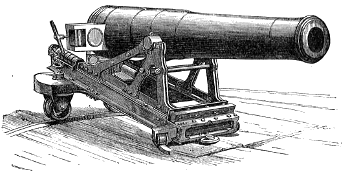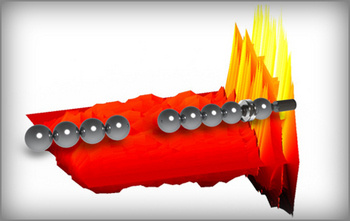Sound and Heat
August 23, 2011
In a
previous article (Bubble Noise Reduction, June 7, 2011), I wrote how bubble arrays can be used to make a
sound-blocking wall in water. Noise barriers can be very difficult to design and implement. At one time, a
college radio station with which I was associated was going to be moved into a new student center. The problem was that the student center would also contain
bowling alleys, and the studio space would be located right behind the pins! After floating a design that included having the studios suspended from
springs, the radio station was relocated to another building.[1]

Old World Noise Maker
A canon manufactured by Krupp.
(Via Wikimedia Commons)
Sound isolation is important on smaller scales, also.
Heat in
materials is conveyed by
acoustic vibrations called
phonons. It's possible to make
thermal barriers by inhibiting the transmission of phonons through a material. At very high temperatures, the phonon scattering needs to occur at short distances to be effective. For those applications,
atomic substitutions that lead to the formation of
lattice vacancies, are effective. Adding
yttrium, a triply-
charged cation, to substitute for quad-charged
zirconium in
zirconia (ZrO
2) has that effect.
At lower
temperatures, phonon scattering is accomplished by structures of larger dimension. It's often accomplished by building the material in layers, each layer having a different
acoustic impedance. In that way, there is
reflection of sound waves at the impedance discontinuities, and this inhibits heat transmission.
In one example, films of
WSe2, where the structure has alternate W and Se layers, were found to have
thermal conductivities as low as 0.05
watt/
meter/
kelvin at
room temperature. This low thermal conductivity was a result of
random stacking of two-dimensional sheets of crystalline WSe
2 that offered enhanced phonon scattering.[3]
Layered combinations of very different materials are very effective thermal insulators. A layered structure of
tungsten and
alumina in which the layers were just a few
nanometers thick, exhibited a thermal conductivity of just 0.6 watt/meter/kelvin.[4] Building nano-dot barriers into
SiGe layered structures resulted in a room temperature thermal conductivity of 0.9 watt/meter/kelvin in multilayers incorporating just five barrier layers.[5]
One interesting discovery is that
phase change materials have remarkably low thermal conductivity in their
crystalline state.[6-7] The thermal conductivity of their crystalline state is not that much different than their
amorphous state. This is advantageous in these materials, which are used as
memory cells, since the heating to cause a
phase change will be localized in both states.
The reason for this effect is as interesting as the effect itself. Quite surprisingly, the amorphous material was found to be
harder than the crystalline material. The short-range
order of the crystalline state is lower than that of the amorphous state. Both the softness of the crystalline state and its lack of short range order inhibit thermal conductivity.[6-7]
The ability to manage thermal conductivity aids thermal design in many cases, so how wonderful would it be to have a "heat diode" that allows heat to flow in one direction, only? Well, we're not there, yet, but there is research in "
sonic diodes" that might lead to such a device. Of course,
thermodynamics still requires heat to flow from a warmer body to a cooler one, but we could impede heat flow in one direction and allow heat flow in the other.
Sonic diodes already exist, and they are made from
metamaterials. One sonic diode device, published in
Physical Review letters by a team of
engineers from
Nanjing University and
Caltech, consists of linear acoustic crystals embedded in a mesh of square
steel rods. Rotating the rods modifies the
crystal unit cell, and this allows either two-way, or one-way sound transmission.[8-9]
Another Caltech team, from the
Department of Engineering and Applied Science, has published another approach in
Nature Materials that could be adapted to small devices.[10-11] Much like the bubble example I cited earlier, the device uses an assemblage of
elastic spheres, with a difference (see figure). The spheres are arranged as periodic chains with a defect that modifies their acoustical properties. The primary advantage of this approach is that there is a sharp transition between acoustic states.

Artistic representation of the Caltech acoustic diode, which uses the asymmetry present in chains of compressed spheres.
(Image: Georgios Theocharis / Caltech)
The Caltech team has proven their device experimentally by making a "
granular crystal" of a statically compressed one-dimensional array of contacting spheres with a light
mass defect near a boundary. Because of this defect, vibrations at selected frequencies cause bifurcations and a subsequent transition to a
chaotic state that transforms the narrow
frequency band to a broadband
spectrum. A
rectification ratio of greater than 10,000 was obtained, and the authors mention application to thermal materials.[11]
References:
- Thanks to colleague station member, Alan F. Miller, for refreshing my memory on some of the details. This happened more than forty years ago.
- Nitin P. Padture, Maurice Gell and Eric H. Jordan, "Thermal Barrier Coatings for Gas-Turbine Engine Applications," Science, vol. 296, no. 5566 (April 12, 2002) pp. 280-284.
- Catalin Chiritescu, David G. Cahill, Ngoc Nguyen, David Johnson, Arun Bodapati, Pawel Keblinski and Paul Zschack, "Ultralow Thermal Conductivity in Disordered, Layered WSe2 Crystals," Science, vol. 315, no. 5810 (January 19, 2007), pp. 351-353.
- R. M. Costescu, D. G. Cahill, F. H. Fabreguette, Z. A. Sechrist and S. M. George, "Ultra-Low Thermal Conductivity in W/Al2O3 Nanolaminates," Science, vol. 303, no. 5660 (February 13, 2004), pp. 989-990.
- G. Pernot, M. Stoffel, I. Savic, F. Pezzoli, P. Chen, G. Savelli, A. Jacquot, J. Schumann, U. Denker, I. Mönch, Ch. Deneke, O. G. Schmidt, J. M. Rampnoux, S. Wang, M. Plissonnier, A. Rastelli, S. Dilhaire and N. Mingo, "Precise control of thermal conductivity at the nanoscale through individual phonon-scattering barriers," Nature Materials, vol. 9, no. 6 (June, 2010), pp. 491-495.
- Angela Wenzik, "Nature of bonding determines thermal conductivity," Helmholtz Association of German Research Centers Press Release, May 3, 2011.
- Toshiyuki Matsunaga, Noboru Yamada, Rie Kojima, Shinichi Shamoto, Masugu Sato, Hajime Tanida, Tomoya Uruga, Shinji Kohara, Masaki Takata, Peter Zalden, Gunnar Bruns, Ilya Sergueev, Hans Christian Wille, Raphaël Pierre Hermann and Matthias Wuttig, "Phase-Change Materials: Vibrational Softening upon Crystallization and Its Impact on Thermal Properties," Advanced Functional Materials, vol. 21, no. 12 (June 21, 2011), pp. 2232-2239.
- Xue-Feng Li, Xu Ni, Liang Feng, Ming-Hui Lu, Cheng He, and Yan-Feng Chen, "Tunable Unidirectional Sound Propagation through a Sonic-Crystal-Based Acoustic Diode," Phys. Rev. Lett., vol. 106, no. 8 (February 25, 2011), Document No. 084301 (4 pages).
- Xue-Feng Li, Xu Ni, Liang Feng, Ming-Hui Lu, Cheng He, and Yan-Feng Chen, "Synopsis: Tunable Unidirectional Sound Propagation through a Sonic-Crystal-Based Acoustic Diode," Phys. Rev. Lett., vol. 106, (February 23, 2011), Document No. 084301.
- Katie Neith, "Caltech Engineers Develop One-way Transmission System for Sound Waves," Caltech Press Release, July 26, 2011.
- N. Boechler, G. Theocharis1 and C. Daraio, "Bifurcation-based acoustic switching and rectification," Nature Materials (Published Online. July 24, 2011).
Permanent Link to this article
Linked Keywords: Soundproofing; sound-blocking; college radio station; bowling alley; spring; Krupp; Wikimedia Commons; heat; material; acoustic vibration; phonon; thermal barrier; atom; lattice vacancy; yttrium; electric charge; cation; zirconium; zirconia; temperature; acoustic impedance; reflection; tungsten; W; selenium; Se; thermal conductivity; watt; meter; kelvin; room temperature; random; alumina; nanometer; SiGe; phase change material; crystalline; amorphous; phase-change memory; phase change; hardness; order; sonic diode; thermodynamics; metamaterial; Physical Review letters; engineer; Nanjing University; California Institute of Technology; Caltech; steel; crystal unit cell; Department of Engineering and Applied Science; Nature Materials; elastic; Georgios Theocharis; granular; mass; chaotic; frequency; spectrum; rectification.